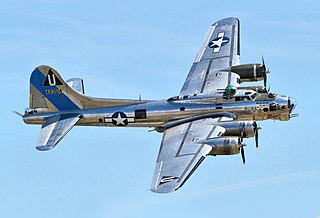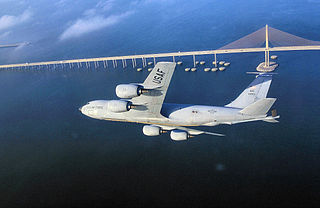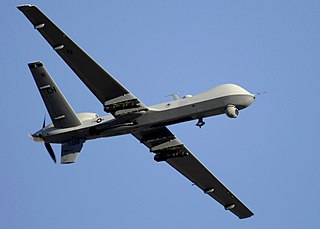
The Boeing B-17 Flying Fortress is an American four-engined heavy bomber aircraft developed in the 1930s for the United States Army Air Corps (USAAC). A fast and high-flying bomber of its era, the B-17 was used primarily in the European Theater of Operations and dropped more bombs than any other aircraft during World War II. It is the third-most produced bomber of all time, behind the American four-engined Consolidated B-24 Liberator and the German multirole, twin-engined Junkers Ju 88. It was also employed as a transport, antisubmarine aircraft, drone controller, and search-and-rescue aircraft.

The Eighth Air Force (Air Forces Strategic) is a numbered air force (NAF) of the United States Air Force's Air Force Global Strike Command (AFGSC). It is headquartered at Barksdale Air Force Base, Louisiana. The command serves as Air Forces Strategic – Global Strike, one of the air components of United States Strategic Command (USSTRATCOM). The Eighth Air Force includes the heart of America's heavy bomber force: the Northrop Grumman B-2 Spirit stealth bomber, the Rockwell B-1 Lancer supersonic bomber, and the Boeing B-52 Stratofortress heavy bomber aircraft.

|}

The 91st Bombardment Group (Heavy) was an air combat unit of the United States Army Air Forces during the Second World War. Classified as a heavy bombardment group, the 91st operated Boeing B-17 Flying Fortress aircraft and was known unofficially as "The Ragged Irregulars" or as "Wray's Ragged Irregulars", after the commander who took the group to England. During its service in World War II the unit consisted of the 322nd, 323rd, 324th, and 401st Bomb Squadrons. The 91st Bombardment Group is most noted as the unit in which the bomber Memphis Belle flew, and for having suffered the greatest number of losses of any heavy bombardment group in World War II.

Royal Air Force Kimbolton or more simply RAF Kimbolton is a former Royal Air Force station located 8 miles (13 km) west of Huntingdon, Cambridgeshire, England.

Royal Air Force Grafton Underwood or more simply RAF Grafton Underwood is a former Royal Air Force station located 4 miles (6.4 km) northeast of Kettering, Northamptonshire, England.

Shoo Shoo Shoo Baby, originally Shoo Shoo Baby, is a Boeing B-17 Flying Fortress in World War II, preserved and currently in storage at the National Museum of the United States Air Force, awaiting transfer to the Smithsonian's National Air and Space Museum. A B-17G-35-BO, serial number 42-32076, and manufactured by Boeing, it was named by her crew for a song of the same name made popular by The Andrews Sisters, the favorite song of its crew chief T/Sgt. Hank Cordes. Photographs of the bomber indicate that a third "Shoo" was added to the name at some point in May 1944 when the original aircraft commander completed his tour of duty and was replaced by another pilot.

Combat America is a 1945 documentary film produced in World War II, narrated by Clark Gable. At the time of the film's production in 1943, Gable was a 1st Lieutenant in the Eighth Air Force, part of the United States Army Air Forces. While he was stationed in England, Gable flew five combat missions from May 4–September 23, 1943, and during one of them, his boot was struck by an anti-aircraft shell, and he was nearly hit by other flak bursts. Gable's film crew included MGM cameraman Andrew J.McIntyre; 1st Lt. Howard Voss, a sound engineer; Master Sgt. Robert Boles, a cameraman; Master Sgt. Marlin Toti, another cameraman; and 1st Lt. John Mahlin, a scriptwriter."

The 310th Space Wing is an Air Reserve Component (ARC) of the United States Air Force. It is assigned to the Tenth Air Force, Air Force Reserve Command, stationed at Schriever Space Force Base, Colorado. The wing is the only space wing in the Air Force Reserve. It provides specialized expertise, continuity and combat ready personnel. It is mission partnered with several United States Space Force deltas: Space Delta 2, Space Delta 3, Space Delta 4, and Space Launch Delta 30.

The 73d Air Division is an inactive United States Air Force unit. Its last assignment was with Air Defense Command at Tyndall Air Force Base, Florida, where it was inactivated on 1 April 1966.

The 32nd Air Refueling Squadron is part of the 305th Air Mobility Wing at Joint Base McGuire-Dix-Lakehurst, New Jersey. It operates the Boeing KC-46A Pegasus aircraft conducting air refueling missions. The squadron is one of the oldest in the United States Air Force, its origins dating to 19 May 1917, being organized at Camp Kelly, Texas. The squadron deployed to England as part of the American Expeditionary Force during World War I. During World War II, the squadron saw combat service as a Boeing B-17 Flying Fortress unit, assigned to the Fifteenth Air Force in Italy. During the early years of the Cold War, it was a Boeing RB-47 Stratojet strategic reconnaissance squadron as part of Strategic Air Command.

The 91st Air Refueling Squadron is part of the 6th Air Mobility Wing at MacDill Air Force Base, Florida. It operates the Boeing KC-135R Stratotanker aircraft conducting air refueling missions.

The 351st Air Refueling Squadron is part of the 100th Air Refueling Wing at RAF Mildenhall, England. Since 1992, it has operated the Boeing KC-135R/T Stratotanker aircraft conducting primarily aerial refueling but also airlift and aeromedical evacuation missions.

The 303rd Air Expeditionary Group is a provisional United States Air Force unit. In 2011, it was assigned to United States Air Forces Europe to activate or inactivate as needed.

The 547th Bombardment Squadron is an inactive United States Air Force unit. It was first activated during World War II as a Boeing B-17 Flying Fortress unit. After training in the United States, it deployed to the European Theater of Operations, where it participated in the strategic bombing campaign against Germany, earning two Distinguished Unit Citations. Following V-E Day, the squadron moved to France and was inactivated there in early 1946.

The 322d Expeditionary Reconnaissance Squadron is a provisional unit of the United States Air Force, assigned to Air Combat Command to activate or inactivate as needed.

The 324th Expeditionary Reconnaissance Squadron is a provisional United States Air Force unit. It is assigned to the 409th Air Expeditionary Group at Naval Air Station Sigonella, Italy.

The 323d Strategic Reconnaissance Squadron is an inactive United States Air Force unit. Its last was assigned to the 91st Strategic Reconnaissance Wing, stationed at Lockbourne Air Force Base, Ohio. It was inactivated on 8 November 1957.

The 342d Bombardment Squadron is an inactive United States Air Force unit. It was last assigned to the 4137th Strategic Wing at Robins Air Force Base, Georgia, where it was inactivated on 1 February 1963.

Dauntless Dotty is the nickname of a Boeing B-29-40-BW Superfortress during the Second World War that led the first B-29 raid on Tokyo on 24 November 1944, the first bombing attack of the Japanese capital since the Doolittle Raid on 18 April 1942.



















